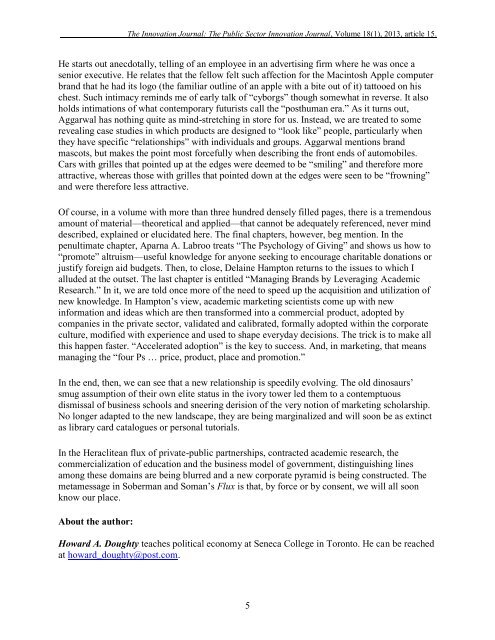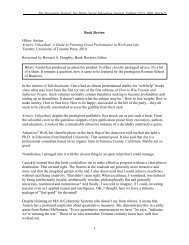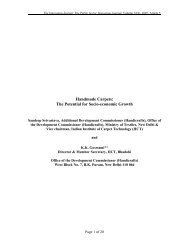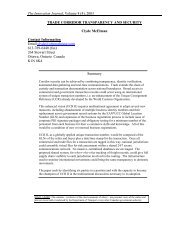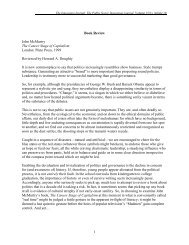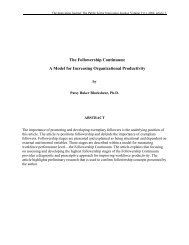What Marketing Managers Need to Navigate the New Environment
What Marketing Managers Need to Navigate the New Environment
What Marketing Managers Need to Navigate the New Environment
Create successful ePaper yourself
Turn your PDF publications into a flip-book with our unique Google optimized e-Paper software.
The Innovation Journal: The Public Sec<strong>to</strong>r Innovation Journal, Volume 18(1), 2013, article 15.<br />
He starts out anecdotally, telling of an employee in an advertising firm where he was once a<br />
senior executive. He relates that <strong>the</strong> fellow felt such affection for <strong>the</strong> Macin<strong>to</strong>sh Apple computer<br />
brand that he had its logo (<strong>the</strong> familiar outline of an apple with a bite out of it) tat<strong>to</strong>oed on his<br />
chest. Such intimacy reminds me of early talk of “cyborgs” though somewhat in reverse. It also<br />
holds intimations of what contemporary futurists call <strong>the</strong> “posthuman era.” As it turns out,<br />
Aggarwal has nothing quite as mind-stretching in s<strong>to</strong>re for us. Instead, we are treated <strong>to</strong> some<br />
revealing case studies in which products are designed <strong>to</strong> “look like” people, particularly when<br />
<strong>the</strong>y have specific “relationships” with individuals and groups. Aggarwal mentions brand<br />
mascots, but makes <strong>the</strong> point most forcefully when describing <strong>the</strong> front ends of au<strong>to</strong>mobiles.<br />
Cars with grilles that pointed up at <strong>the</strong> edges were deemed <strong>to</strong> be “smiling” and <strong>the</strong>refore more<br />
attractive, whereas those with grilles that pointed down at <strong>the</strong> edges were seen <strong>to</strong> be “frowning”<br />
and were <strong>the</strong>refore less attractive.<br />
Of course, in a volume with more than three hundred densely filled pages, <strong>the</strong>re is a tremendous<br />
amount of material—<strong>the</strong>oretical and applied—that cannot be adequately referenced, never mind<br />
described, explained or elucidated here. The final chapters, however, beg mention. In <strong>the</strong><br />
penultimate chapter, Aparna A. Labroo treats “The Psychology of Giving” and shows us how <strong>to</strong><br />
“promote” altruism—useful knowledge for anyone seeking <strong>to</strong> encourage charitable donations or<br />
justify foreign aid budgets. Then, <strong>to</strong> close, Delaine Hamp<strong>to</strong>n returns <strong>to</strong> <strong>the</strong> issues <strong>to</strong> which I<br />
alluded at <strong>the</strong> outset. The last chapter is entitled “Managing Brands by Leveraging Academic<br />
Research.” In it, we are <strong>to</strong>ld once more of <strong>the</strong> need <strong>to</strong> speed up <strong>the</strong> acquisition and utilization of<br />
new knowledge. In Hamp<strong>to</strong>n’s view, academic marketing scientists come up with new<br />
information and ideas which are <strong>the</strong>n transformed in<strong>to</strong> a commercial product, adopted by<br />
companies in <strong>the</strong> private sec<strong>to</strong>r, validated and calibrated, formally adopted within <strong>the</strong> corporate<br />
culture, modified with experience and used <strong>to</strong> shape everyday decisions. The trick is <strong>to</strong> make all<br />
this happen faster. “Accelerated adoption” is <strong>the</strong> key <strong>to</strong> success. And, in marketing, that means<br />
managing <strong>the</strong> “four Ps … price, product, place and promotion.”<br />
In <strong>the</strong> end, <strong>the</strong>n, we can see that a new relationship is speedily evolving. The old dinosaurs’<br />
smug assumption of <strong>the</strong>ir own elite status in <strong>the</strong> ivory <strong>to</strong>wer led <strong>the</strong>m <strong>to</strong> a contemptuous<br />
dismissal of business schools and sneering derision of <strong>the</strong> very notion of marketing scholarship.<br />
No longer adapted <strong>to</strong> <strong>the</strong> new landscape, <strong>the</strong>y are being marginalized and will soon be as extinct<br />
as library card catalogues or personal tu<strong>to</strong>rials.<br />
In <strong>the</strong> Heraclitean flux of private-public partnerships, contracted academic research, <strong>the</strong><br />
commercialization of education and <strong>the</strong> business model of government, distinguishing lines<br />
among <strong>the</strong>se domains are being blurred and a new corporate pyramid is being constructed. The<br />
metamessage in Soberman and Soman’s Flux is that, by force or by consent, we will all soon<br />
know our place.<br />
About <strong>the</strong> author:<br />
Howard A. Doughty teaches political economy at Seneca College in Toron<strong>to</strong>. He can be reached<br />
at howard_doughty@post.com.<br />
5


